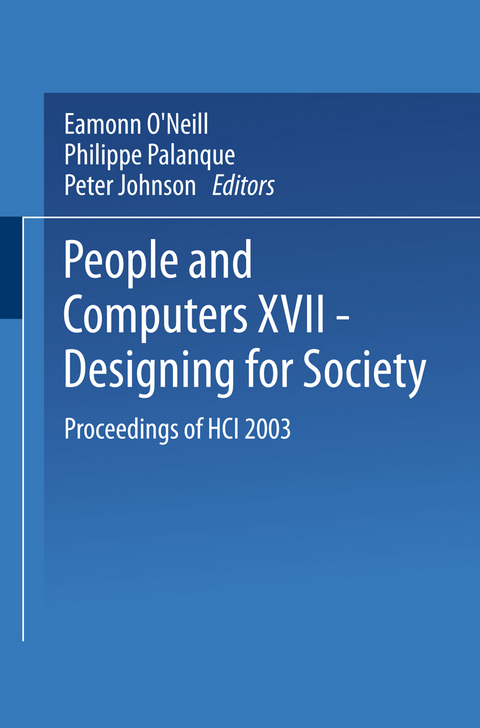
People and Computers XVII — Designing for Society
Springer London Ltd (Verlag)
978-1-85233-766-7 (ISBN)
HCI is a fundamental and multidisciplinary research area. It is fundamental to the development and use of computing technologies. Without good HCI, computing technologies provide less benefit to society. We often fail to notice good HCI. Good HCI passes us by without comment or surprise. The technology lets you do what you want without causing you any further work, effort or thought. You load a DVD into your DVD player and it works: why shouldn't it? You take a photograph with your digital camera and without any surprise you easily transfer and view these on your computer. You seamlessly connect to networks and devices with a common interface and interaction style. Yet when HCI is wrong the technology becomes useless, unusable, disrupts our work, inhibits our abilities and constrains our achievements. Witness the overuse and inconsistent use of hierarchical menus on mobile phones; or the lack of correspondence between call statistics on the phone handset itself and the billed call time on the account bill; or the lack of interoperability between file naming conventions on different operating systems running applications and files of the same type (e. g. the need for explicit filename suffixes on some operating systems). Those programmers, designers and developers who know no better, believe that HCI is just common sense and that their designs are obviously easy to use.
Doing the Right Thing in the Right Place: Technology, Theory and Design for Multiple and Group Activities.- Understanding Task Grouping Strategies.- Two Phenomenological Studies of Place.- The Interaction Character of Computers in Co-located Collaboration.- Information Retrieval.- How Knowledge Workers Gather Information from the Web: Implications for Peer-to-Peer File Sharing Tools.- Evaluation of a Prototype Interface for Structured Document Retrieval.- Comparing Speed-dependent Automatic Zooming with Traditional Scroll, Pan and Zoom Methods.- Design Methods and Principles.- The Application of Urban Design Principles to Navigation of Information Spaces.- A Method for Organizational Culture Analysis as a Basis for the Implementation of User-Centred Design into Organizations.- Evaluation Methods.- Changing Analysts’ Tunes: The Surprising Impact of a New Instrument for Usability Inspection Method Assessment.- Ontological Sketch Models: Highlighting User-System Misfits.- Interaction Techniques: Looking, Listening, Pointing, Stroking.- Improving the Acquisition of Small Targets.- A Directional Stroke Recognition Technique for Mobile Interaction in a Pervasive Computing World.- Look or Listen: Discovering Effective Techniques for Accessing Speech Data.- E-commerce.- Social and Cultural Obstacles to the (B2C) E-Commerce Experience.- Trust at First Sight? A Test of Users’ Ability to Identify Trustworthy E-commerce Sites.- ‘On the Move’: Mobile Interaction.- MovieLens Unplugged: Experiences with a Recommender System on Four Mobile Devices.- Effective Web Searching on Mobile Devices.- M-RSVP: Mobile Web Browsing on a PDA.- Accessibility.- Fancy Graphics Can Deter Older Users: A Comparison of Two Interfaces for Exploring Healthy Lifestyle Options.- Towards VoiceXMLDialogue Design for Older Adults.- WebTouch: An Audio-tactile Browser for Visually Handicapped People.- Two Falls out of Three in the Automated Accessibility Assessment of World Wide Web Sites: A-Prompt vs. Bobby.- ‘Look at Me’: Emotions, Faces and Eyes.- Expressive Image Generator for an Emotion Extraction Engine.- An Exploration of Facial Expression Tracking in Affective HCI.- Could I have the Menu Please? An Eye Tracking Study of Design Conventions.- Author Index.- Keyword Index.
| Zusatzinfo | 88 Illustrations, black and white; XVI, 418 p. 88 illus. |
|---|---|
| Verlagsort | England |
| Sprache | englisch |
| Maße | 155 x 235 mm |
| Themenwelt | Mathematik / Informatik ► Informatik ► Betriebssysteme / Server |
| Mathematik / Informatik ► Informatik ► Datenbanken | |
| Informatik ► Software Entwicklung ► User Interfaces (HCI) | |
| Mathematik / Informatik ► Informatik ► Web / Internet | |
| ISBN-10 | 1-85233-766-4 / 1852337664 |
| ISBN-13 | 978-1-85233-766-7 / 9781852337667 |
| Zustand | Neuware |
| Haben Sie eine Frage zum Produkt? |
aus dem Bereich


